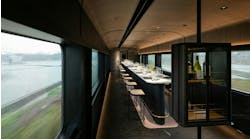Designers have an ongoing interest in materiality not only because it pertains to certain physical properties of building materials and finishes, but also because of its intangible value. The relevance of materiality in interiors in terms of its impact on a space and its occupants is perhaps more important than ever.
Allow me to explain.
We’re at a pivotal moment in time in the design industry. Never before has there been such an intense focus on the genetic makeup of the materials, products and furnishings that designers specify. Like the sustainability movement before it, the health and wellness trend has brought materiality to the forefront of the design conversation—but with an even greater urgency, I believe.
Because when people start asking questions like, “Shouldn’t we be able to design a cancer center without carcinogens?” designers like Mary Dickinson and Max Richter, co-directors of Perkins and Will’s Materials Performance Lab and our featured Profile for October, have devoted themselves to finding the answer—and others like it.
“Right now, one of the big questions is: How do you make the connections and make decisions when holding human health, environmental health and carbon in tandem to make product and material selections?” Dickinson says.
To that end, the Materials Performance Lab acts as a kind of support system for the firm’s studios around the world, with a team of more than 50 practitioners conducting research into materials and their impact on human health and the environment. Dickinson says the lab stays connected to projects and teams to determine what needs and questions they have in order to conduct research and report back out to the firm to help inform the design process.
And the process has never been quite as complex, it seems. Advances in technology, changing behaviors toward climate and sustainability, and an increased understanding of how interiors affect our everyday lives have propelled the need for designers to be multidisciplinary experts in many ways (see IIDA).
Beyond collaborating with various industries or professions, interdisciplinary design involves applying the skills, knowledge and belief systems of multiple disciplines. This can provide designers the opportunities to take on involved, unique projects; employ multi-faceted project teams and stay ahead of the curve in their industry.
Speaking of being on the cutting edge, we recently took a look at SmartBark, a low-resolution ambient display panel made of a single flattened piece of tulip poplar bark. It is embedded with LEDs, or “pixels,” that display animations depicting live-stream current weather conditions.
SmartBark is the first panel of its kind to fully integrate and embed technology that aims to increase occupant performance and overall wellbeing. Based on the intersection between architecture, interior design and ubiquitous computing through interactive environments, SmartBark is a merger of nature and technology.
Sometimes inspiration for innovation is found in the past, as is the case with Patcraft’s new Metal Collective collection. Borrowing from the centuries-old Japanese concept of Kintsugi in which broken pottery is put back together with lacquer that is mixed or dusted with metallic powder, the idea behind Metal Collective was to create something new by restoring broken and imperfect items.
As such, Kintsugi treats breakage and repair as part of pottery’s design history and sustainability, and the same approach can be applied to product and space design.
With sustainability in mind, October’s Product Breakdown features the 100% regenerated and regenerable ECONYL nylon. Through chemical and mechanical processes, nylon is recovered and recycled from waste materials including fishing nets, textile scraps, and carpets and transformed into nylon yarn.
“We want to inspire change, both in the way that architects and designers look for materials and the way they design the final products. We rely on architects and designers to see the waste issue as a pressing matter and inspire them to create with sustainable materials in the first phase of product development,” says Aquafil CEO and chairman Giulio Bonazzi.
As we explore the topic of materiality more deeply throughout October’s, it’s my hope that you see the world of materials afresh and consider the possibilities—both past, present and future.
Read next: Healthy Materials Lab


